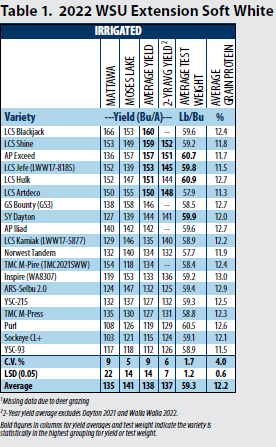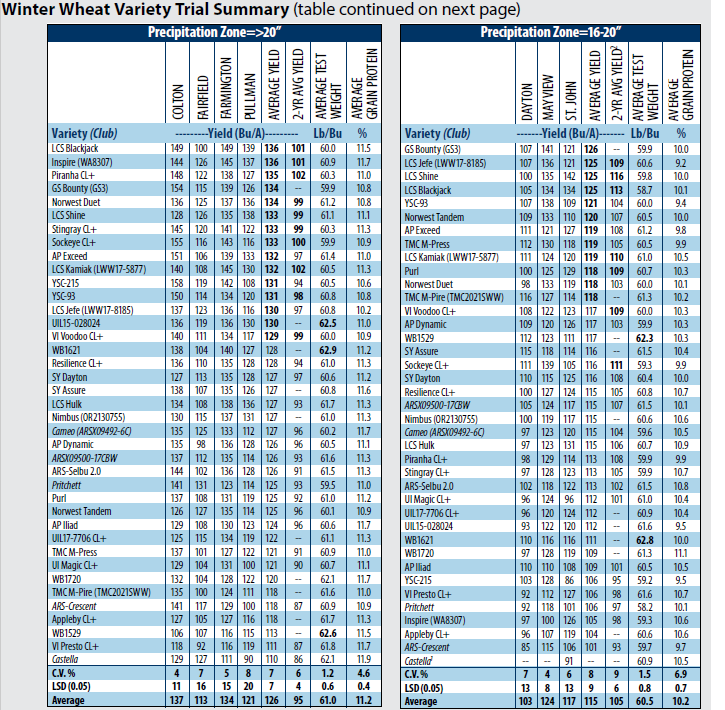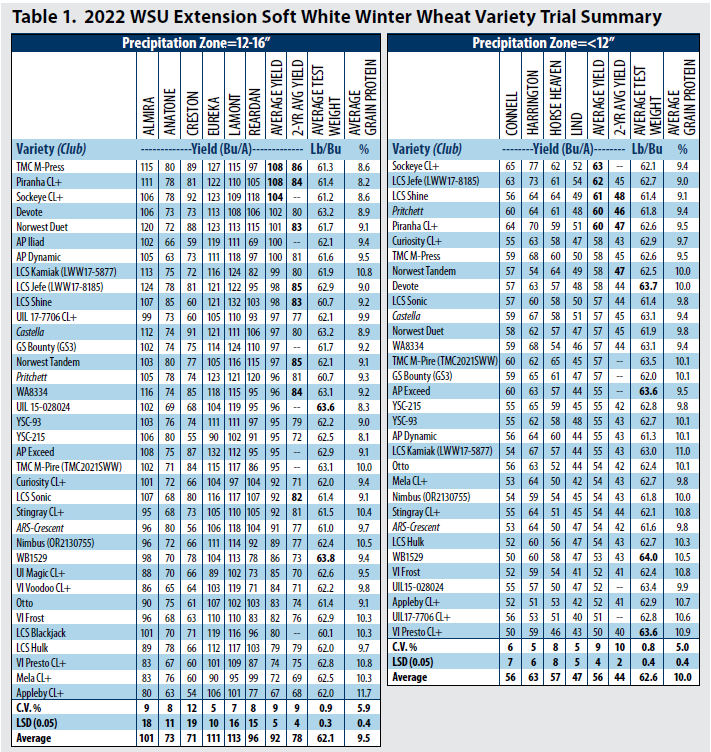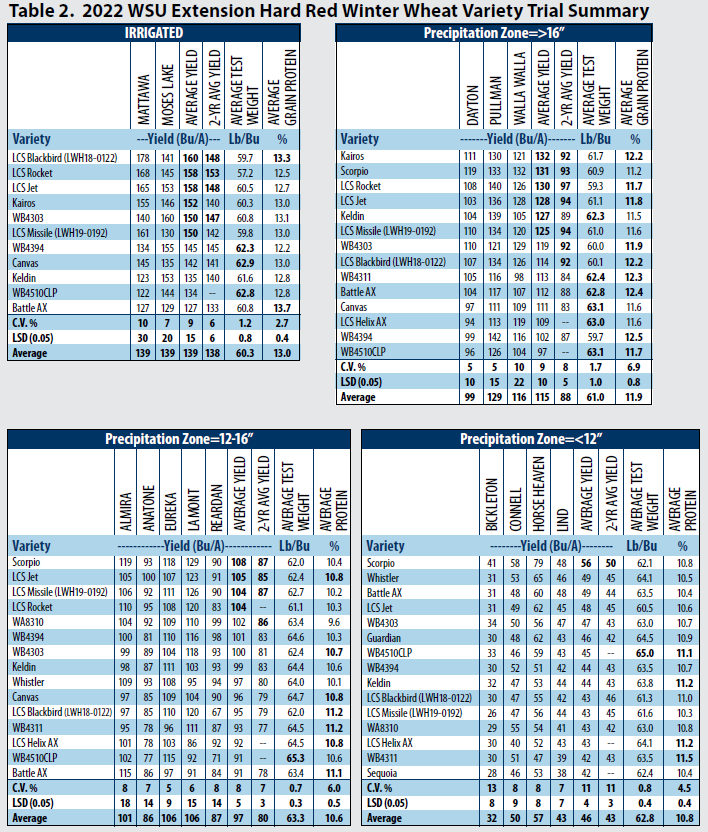By Clark Neely
Anyone growing winter wheat these days in Eastern Washington knows there is a plethora of varieties to choose from. What makes things even more challenging is the increasing rate at which many of these varieties are turning over. The past two years, 2022 and 2023, have been no exception with what has been another flurry of new winter wheat variety releases and more waiting in the wings.
Hopefully, the data generated by the Washington State University (WSU) Variety Testing Program can help you make sense of a crowded field of contestants and provide you with the best and latest comparisons possible. Here is a rundown of
the latest and greatest in winter wheat varieties.
Soft white winter wheat
In 2022, there were five new soft white winter wheat varieties named, which included Geneshifter (GS) Bounty (GS3); WSU varieties Inspire (WA8307) and Jameson (WA8290); Limagrain (LCS) Jefe (LWW17-8185); and The McGregor Company (TMC) M-Pire (TMC2021SWW). Another two new prereleased varieties were also added by WestBred, WB1621 and WB1720.
GS Bounty is a variety with one year of data in the WSU trials. It shows very good yield potential in the high rainfall regions over 16 inches of precipitation based on 2022 data. Yields were above average under irrigation and close to average below 16 inches. Test weight is acceptable, generally coming in just under the trial average. GS Bounty is one of the better emerging lines with a rating just under Mela CL+ and Otto, but slightly better than LCS Hulk. It is rated intermediate for cold tolerance, mostly tolerant to aluminum, excellent for straw strength, but is moderately susceptible to stripe rust.
The WSU variety, Inspire, performed best in the over-20-inch precipitation zone with yields comparable to Norwest Duet and LCS Shine. Inspire has produced good test weight with excellent winter survival, good straw strength, excellent stripe rust resistance, and desirable end-use quality. It is a medium-tall variety with medium maturity. It also has resistance to eyespot foot rot and is highly tolerant of cephalosporium stripe.
Jameson was tested in the below-12-inch  and 12-to-16-inch zones from 2018-2021, where it landed near the trial average for yield with average to slightly below average test weight. It is targeted for the Highway 2 region and is a 5+10 glutenin variety with most desirable end-use quality and good falling numbers. It is one of the best varieties for emergence, comparable to Otto and Devote, and has similar cold tolerance as LCS Shine and TMC M-Press. It also has resistance to eyespot foot rot, moderately good snow mold resistance, and, importantly, has strong resistance to stripe rust.
and 12-to-16-inch zones from 2018-2021, where it landed near the trial average for yield with average to slightly below average test weight. It is targeted for the Highway 2 region and is a 5+10 glutenin variety with most desirable end-use quality and good falling numbers. It is one of the best varieties for emergence, comparable to Otto and Devote, and has similar cold tolerance as LCS Shine and TMC M-Press. It also has resistance to eyespot foot rot, moderately good snow mold resistance, and, importantly, has strong resistance to stripe rust.
LCS Jefe appears to be a broadly adapted variety, landing in the top third of the trial in all precipitation zones and excelling the most in the intermediate precipitation zones on the two-year averages. Test weight is good, while straw strength, winter survival, tolerance to aluminum, and resistance to stripe rust are all rated excellent. While LCS Jefe typically emerges fine in deep furrow plantings under good moisture conditions, it struggles under less-than-ideal planting conditions, with a similar emergence rating as LCS Shine. Compared to the average variety, LCS Jefe tends to be more prone to falling number issues and has a similar rating as Pritchett.
Oregon State University officially named Nimbus (OR2130755) in 2022. It has one year in the trials over 16 inches and two years below 16 inches. In every case, it landed within one bushel of the trial average. Test weight and protein also were close to average in every case. Nimbus has a good overall agronomic package, with good winter survival, aluminum tolerance, straw strength, stripe rust resistance, and end-use quality. Emergence is rated intermediate.
TMC M-Pire was first tested by WSU in 2022. In its first year, TMC M-Pire landed in the top yielding group in the 16-to-20-inch precipitation zone, but was closer to the trial average below 16 inches, and below average in the over-20-inch zone. TMC M-Pire has excellent test weight, stripe rust resistance, and straw strength. It is rated intermediate for aluminum tolerance and cold tolerance. It also has a short stature and is early-medium for time to heading.
LCS Kamiak (LWW17-5877) was only recently named in the spring of 2023 and has been tested since 2021 in all precipitation zones. Based on the two-year yield average, LCS Kamiak appears to be best suited for regions receiving over 16 inches of precipitation, where it lands near the top of the trial. Both test weight and yield trend lower and protein trends well above average with lower precipitation, though protein was generally acceptable at locations over 16 inches of precipitation. Winter survival, straw strength, and stripe rust resistance are all rated excellent. LCS Kamiak has mediumshort height with medium-early heading.
WA8334 is a WSU variety that will be named in spring 2023. This variety is targeted for the lower rainfall regions of Washington. Like Jameson, it contains the 5+10 glutenin profile that produces a stronger dough. On the two-year average, WA8334 was competitive with the other best yielding varieties in the 12-to-16-inch zone, while it landed near the trial average for the less-than-12-inch zone. Its ranking does improve, though, if looking primarily at deep furrow sites and excluding no-till sites such as Bickleton and Horse Heaven for the below-12-inch zone. Test weight and stripe rust resistance are very good with this variety, however, cold tolerance and snow mold are not as strong and is likely best adapted south of Highway 2. Emergence ratings are similar to what we see with LCS Sonic and ARS Crescent.
Other newly added varieties in 2022 included two WestBred varieties, WB1621 and WB1720, in the two higher rainfall zones. WB1621 was the clear winner compared to WB1720 or WB1529 in the over-20-inch zone, though WB1529 beat out both WB1621 and WB1720 in the 16-to-20 inch zone. WB1621 and WB1720 received resistant and moderately resistant marks, respectively, for stripe rust in 2022 and mostly tolerant ratings for aluminum tolerance. Look for these varieties, plus WB1922, in all trial locations in 2023.
Cameo (ARSX09492-6C) is a U.S. Department of Agriculture Agricultural Research Service (ARS) winter club wheat that was technically released in 2021, but is worth mentioning once again. Last year, 2022, turned out to be an excellent year to showcase one of Cameo’s biggest advantages over other winter club wheats in higher rainfall regions of Eastern Washington, which is straw strength. Lodging notes were taken at three variety trials in 2022, and in every case, Cameo came in 50 percentage units lower lodging compared to Castella. Other positive traits for Cameo include a mostly tolerant rating for aluminum tolerance, good winter survival, and resistance to Hessian fly and stripe rust. Test weight is comparable to ARS Crescent, though grain protein runs higher than ARS Crescent, similar to Castella. Falling number values are a significant improvement over Pritchett and comparable to Castella with most desirable enduse quality. Cameo receives good marks for straw breaker foot rot and is intermediate for cephalosporium stripe tolerance.
Both UIL15-028024 and UIL17-7706 CL+ are pending Plant Variety Protection (PVP) approval for release in 2023 as well.
Hard red winter wheat
The only newly added varieties in 2022 in the hard red winter wheat trials were WB4510CLP, a
replacement for WB4623CLP, and LCS Helix AX, which replaced LCS Fusion AX. WB4510CLP was on par with the trial average in the lessthan-12-inch precipitation zone, but was last or next to last in all other zones for yield. It typically has the best test weight in the trial with average grain protein. Currently, it is the only Clearfield variety in the trial. LCS Helix AX was below average for yield in every precipitation zone tested, with below-average emergence and lodging ratings. Stripe rust resistance is rated at moderately susceptible and end-use quality is acceptable. Compared to the only other CoAXium variety in the trial, Battle AX, they were statistically no different for yield above 12 inches, but Battle AX outyielded LCS Helix AX by six bushels below 12 inches.
In spring 2023, Limagrain announced LCS Blackbird (LWH18-0122) and LCS Missile (LWH19-0192). Of the two, LCS Missile had a stronger performance in locations over 12 inches, landing in the top group on the two-year average. Both did well under irrigation, but LCS Blackbird took the number one spot in 2022 in the irrigated trials overall. In most cases, LCS Missile has a 0.5-1.0 pound better test weight over LCS Blackbird, while LCS Blackbird has a 0.7-1.0 percentage unit better grain protein. Both are resistant to stripe rust, but received poor marks for emergence. LCS Missile also received better scores for winter survival and aluminum tolerance.
Lastly, WSU will be naming WA8310 in 2023. WA8310 has really excelled in the 12-to-16-inch precipitation zone, tying Scorpio and LCS Jet for best yield on the two-year average. It produced about 1 pound per bushel better test weight than either Scorpio or LCS Jet as well. While WA8310 produced acceptable protein in the below-12-inch zone, growers are encouraged to push nitrogen to this variety as it consistently came in around 0.7 percentage units lower than Scorpio and LCS Jet in the 12-to-16-inch zone. Emergence ratings have been low, and winter survival is intermediate. Stripe rust and aluminum tolerance ratings are listed as moderately resistant and moderately tolerant, respectively, while preliminary end-use quality ratings are very good.
New ratings
In 2022, the WSU Variety Testing Program generated some new ratings that are now available on its website and through the variety selection tool. These include updated emergence, winter survival, falling number, end-use quality, and stripe rust ratings and brand new ratings for lodging and aluminum tolerance. Winter conditions did not conspire to produce any useful snow mold ratings this past year, but new ratings are expected for spring of 2023.
To view additional ratings and the full results from these trials, please visit the 2022 Variety Testing Data & Maps online. When possible, always use multiple years and locations within a region to better gauge the adaptation and yield stability of a particular variety. Growers and seed dealers are also encouraged to check out the new WSU Variety Selection Tool mobile app for easy access to data on the go. And lastly, all WSU field days, along with Oregon State University and University of Idaho field days, are listed on the WSU Small Grains Extension Website.
Acknowledgements: Funding for the WSU Extension Uniform Cereal Variety Testing Program is provided by the Washington Grain Commission. Variety trials are made possible by the contribution of land and time from farmer cooperators.
This article originally appeared in the May 2023 issue of Wheat Life Magazine.

Clark Neely, Ph.D.
Clark Neely is the cereal variety testing lead and extension agronomist at Washington State University. His research interests include dryland cropping systems and advancing cereal variety testing. Read more about Dr. Neely.



